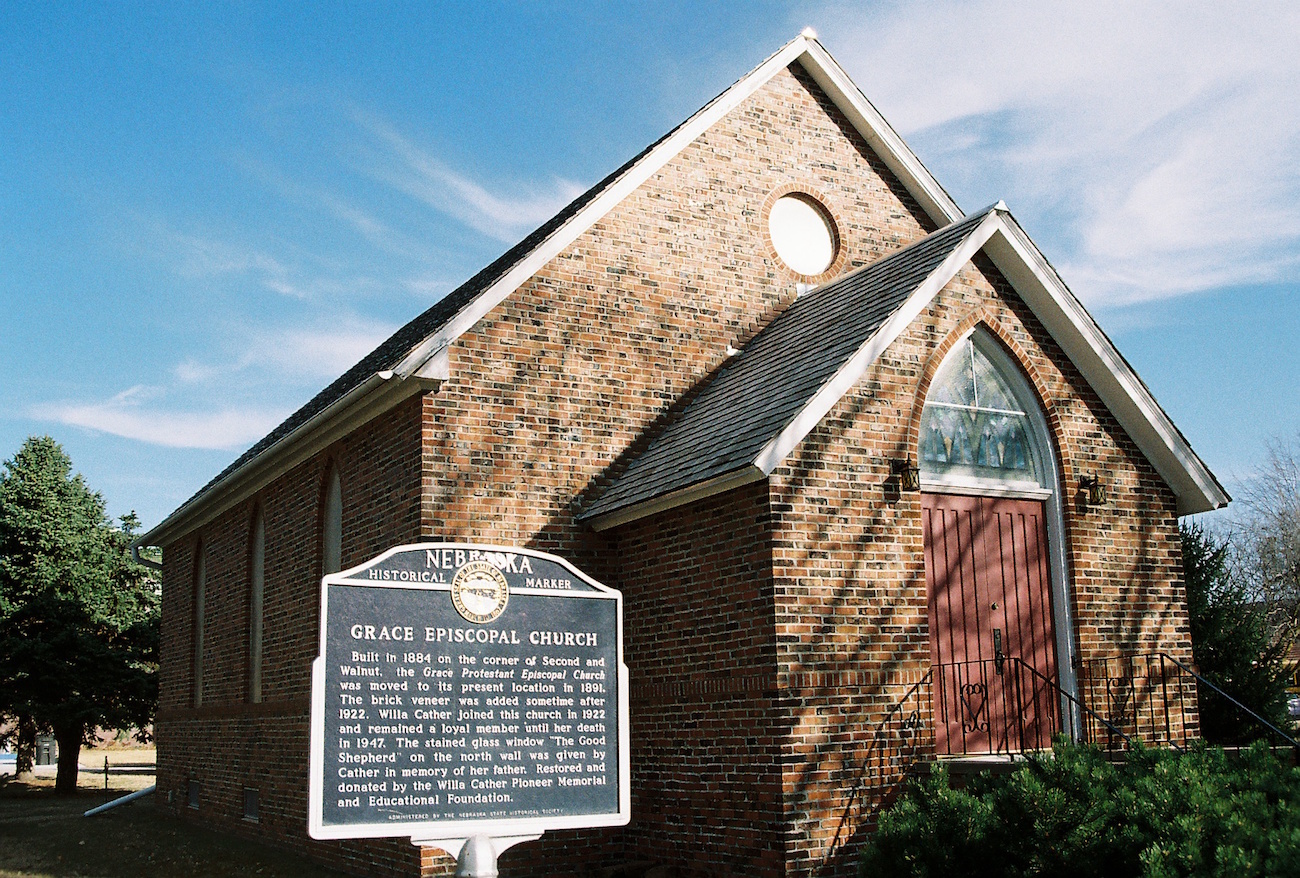When I first read O Pioneers!, the 1913 novel by Willa Cather set in a small Nebraska town, I loved its main character, Alexandra Bergson. Often described wearing men’s clothing, Alexandra takes on traditional “men’s” labor and runs the family farm when her brothers prove too inept. I obsessed over her competence and power, but I also appreciated the huge love she had for the land—a love that made me fondly remember my own family reunions in Nebraska. In the 1920s, Cather’s books were radical; she wrote about what it means to be “American”—especially in the Midwest and among the Swedish and Czech immigrant communities that settled there—and today, 70 years after her death, her work continues to resonate, not least because scholars still debate whether it’s appropriate to consider them in the context of Cather’s relationships with women.
In early March, my friend Gage and I made a pilgrimage to the Willa Cather House in Red Cloud, Nebraska. I’d wanted to visit ever since I learned it was a 90-minute drive from the tiny town where my father was born, and on the trip west from Iowa City I recognized the cornfields and fat horizon from the introduction to Cather’s 1918 novel My Ántonia. Jim Burden, the book’s narrator, and a childhood friend take a train through Iowa, and the friend remarks,
Videos by VICE
Read more: Even Joan Didion’s Unfinished Notes Are Good as Hell
We were talking about what it is like to spend one’s childhood in little towns like these, buried in wheat and corn, under stimulating extremes of climate: burning summers when the world lies green and billowy beneath a brilliant sky, when one is fairly stifled in vegetation… blustery winters with little snow, when the whole country is stripped bare and grey as sheet-iron. We agreed that no one who had not grown up in a little prairie town could know anything about it.
In Cather’s novels, landscape locates us in the region of a specific people; we need to understand a place before we can understand who lives there, and her descriptions, detailed and tender, make us feel as if we’re traveling. In that same passage from My Ántonia, Jim and his friend talk about their childhood friend, an immigrant girl from Bohemia (present-day Czech Republic) named Ántonia Shimerda, and decide that “more than any other person we remembered, this girl seemed to mean to us the [America].” People belong to the place they live—including and especially the immigrants and refugees who came (and are coming) here, like Ántonia Shimerda and her family. “It was risky, in the early part of [the 20th] century, to presume to write fiction about ordinary, rough-hewn people engaged in the rigors of dry land farming in frontier Nebraska,” Kathleen Norris writes in her introduction to the novel. But Cather manages to capture the ordinary. Walking around Red Cloud toward the end of an unseasonably warm March afternoon, I saw that Cather had reflected the quiet beauty of this town in her spare, lyrical writing. The soft play of light on the brick buildings and the faint early spring birdcall seemed like a scene straight out of one of her Nebraska novels.

Photos by the author
Cather’s writing resists being overwrought while inflecting grace into what’s beautiful and tragic about the everyday. After graduating from college, Cather moved to Pittsburgh, worked as an editor at Home Monthly magazine, taught high school, and lived in the same bedroom as Isabelle McClung—a woman she called “the love of her life.” After ten years, she went to New York City, where she worked as an editor at McClure’s Magazine, which would publish her first novel in serial, and lived in an apartment with her partner Edith Lewis. But her most successful novels took place in the Midwest and turned the scope of literature away from away from what Norris calls “overrefined… European pretensions” and toward ordinary people.
Cather was not originally from the Midwest; like Jim, the narrator of My Ántonia, she was born in Virginia in 1873 and moved to Nebraska with her family when she was nine years old. Particularly in the late 19th century, she had the unusual experience of growing up somewhere she wasn’t “from”; she held a type of outsider status that probably contributed to her skill as an observer. “I was little and homesick and lonely,” she told an interviewer about her family’s move. “So the country and I had it out together and by the end of the first autumn the shaggy grass country had gripped me with a passion that I have never been able to shake.”

On my tour of Cather’s home, the volunteer docent told me that the people of Red Cloud recognized which of them Cather was writing about in any given work—and they were not happy about it. The cashier at the local general store, Casey’s, told us that his great-grandmother was Anna Pavelka, the inspiration for My Ántonia’s titular character. Cather’s legacy occupies a tenuous spot in the small town, which has a population of 1,050 today. There’s a lot of hometown pride—every local business had a poster supporting the women’s high school basketball team, which made it to the state championships despite its small size (six people). On a Saturday night, Gage and I were the only two outsiders at the only bar in town, South 40, and everyone suspected we were there “for Willa Cather.” A few people told us they didn’t like her books that much. One man—who beat us pretty badly in pool—told us that he preferred Death Comes for the Archbishop, which is set in New Mexico, over her novels set in Nebraska. He didn’t care for the descriptions of the rolling prairies and Midwestern beauty—he saw that every day while working on his farm and found the written landscapes boring. But he liked Cather’s descriptions of New Mexico—when reading a book like that, he said he was able to travel to an unfamiliar place in his own country.
Gage and I arrived in Red Cloud the weekend before the Cather Foundation‘s “soft opening” for its new museum and educational center in the converted Opera House on the main street—one of Cather’s favorite places in town. Today, you can still tell how bright and beautiful it must have seemed to the young girl. When she was 14, she and her friends put on a performance of Beauty and the Beast in the Opera House. They charged 25 cents a show and made $40, which they donated to immigrant families in the town who were struggling financially. You can see the room it was performed in, renovated but made to look like the original stage. Willa played a merchant; the museum has a photo of her dressed in drag wearing a fabulous wax mustache and hat with her friends, who are all in dresses.

Cather—now sometimes considered a queer author after some debate about her correspondence regarding “feminine friendships”—often played with gender. A portrait of her at the age of 14 in one of the Foundation’s buildings—an old, dark bank, owned by the husband of the woman about whom Cather wrote A Lost Lady—shows Cather with closely cropped hair, a cut she got after her family refused to take her seriously when she signed all her letters “William Cather, M.D.” (Cather badly wanted to be a doctor until she was halfway through classes at the University of Nebraska–Lincoln and a professor sent one of her essays to a local paper. Once Cather saw her name in print, she was hooked.)
Cather’s resistance to traditional femininity—her short hair, her drag performances, her choice not to marry a man—also figures in certain female characters in her novels. O Pioneers!‘s Alexandra Bergson was a woman who took on a “man’s job”—running her family’s homestead—and did it better than her brothers and her male neighbors. Alexandra ends up marrying Carl Linstrum—but as “just friends.” As Joan Acocella put it in the New Yorker, Cather’s fiction “rarely represents a heterosexual relationship that has any romantic or sexual glow to it.” It’s full of what I like to call queer reticence: What she leaves unsaid—and the small details she chooses to emphasize—subtly point savvy readers toward a delicate and understated conclusion. In the same way one might read Elizabeth Bishop’s poem “Crusoe in England” as an elegy for her former partner Lota De Macedo Soares, with gender subversion meant to obscure its true romantic gesture—reading Bishop as the lonely Crusoe and Soares as Friday (“If only he had been a woman!”)—one might read the relationship between Father Latour and Father Vaillant in Cather’s 1927 novel Death Comes for the Archbishop as masked homosexual love. In the penultimate chapter, Father Latour, in the final stages in life, and lies in bed “thinking over his life… he was almost certainly thinking of Joseph: of their life together here, in this room.” He recalls the two of them as young men in France, deciding to become missionaries even though “both the young priests knew that their families would strongly oppose their purpose, so they resolved to reveal it to no one: to make no adieux, but to steal away.” In the stealth and fervor of the two men’s relationship, I suspect a coded nod toward passion that might exist between two people of the same sex, to a love that dare not speak its name. The queerness is coded and almost entirely hidden, but it’s there.
For More Stories Like This, Sign Up for Our Newsletter
Nevertheless, the beauty of Cather’s novels still charms readers today. Though she is not immune to shortcomings—especially in Death Comes for the Archbishop, a novel that celebrates the colonial expansion of the United States, Cather’s characters rely heavily on flattening stereotypes while discussing the indigenous people of New Mexico—her direct and lyric prose tells the stories of the everyday with nuance and subtlety, making room for those who are considered “other.” At a time when queer lives are under attack and travel bans make immigrants feel unsafe, her elegant novels manage to make room for difference as they elevate the ordinary. They remind us that the stories of Americans are American stories.




